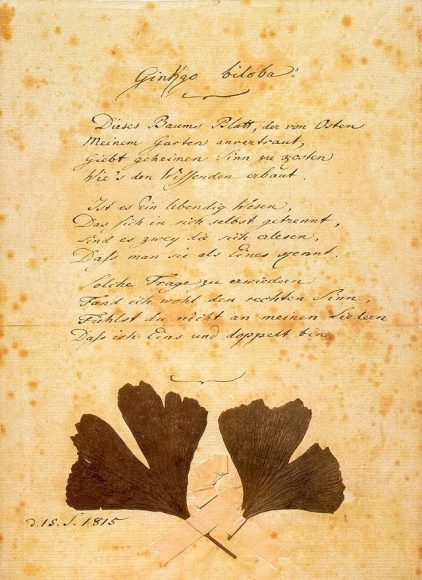
Ginkgo Biloba, 1815 (original in Goethe Museum, Düsseldorf), poem by Johann Wolfgang von Goethe (1749-1832) Public domain
The zeitgeist of our times is characterized by creativity and innovation, particularly in the fields of art and science. A question often pondered is where these two fields intersect. Do they touch each other at a tangent? Do they cross each other? Do they simply overlap? Or perhaps that is a moot point, and never the twain shall meet (to paraphrase Rudyard Kipling).
Kipling addressed the wrong question when he pontificated that East and West would never meet because they are merely two arbitrary points in an endless continuum. This is also true for art and science, since both disciplines are part of a never-ending human quest for knowledge and understanding. An eight-year old child once delighted grownups when she said that in science you discover something and in art you do what you like! Let’s recall what some well-known grownups have said on the subject.
Lucius Annaeus Seneca, a mathematician and a philosopher, believed that all art is merely an imitation of nature. This definition would have pleased artists like Michelangelo, who studied anatomy assiduously to produce sculptures more perfect than the bodies of mere mortals. But Leonardo da Vinci, a contemporary of Michelangelo, might disagree – he went on record publicly disparaging Michelangelo’s art. Perhaps this was because da Vinci, aside from being a consummate artist, was also a methodical man of science, an innovative inventor and the original Renaissance man. Or perhaps he would have disagreed with the notion that art is an imitation of nature simply because René Descartes (17th-century French philosopher and mathematician) hadn’t yet come along to predicate that perception is unreliable and reason is the only path to the natural sciences.
On the other hand, 20th-century Austrian philosopher Ludwig Wittgenstein affirmed that what cannot be imagined cannot even be talked about. Picasso, the father of cubism, certainly wasn’t a rationalist. He firmly believed that anything you can imagine is real. The cubist portraits of the women in his life are living proof that he perceived their multifaceted personalities. René Magritte, Belgian surrealist, considered art to be a science – that is, a way of knowing – because it evokes the mystery without which the world would not exist. Salvador Dali, the Catalan surrealist whose iconic clocks bent like warped time/space, had been highly impressed by Einstein’s recent discoveries. Frida Kahlo, Mexican painter and feminist, did not have to study anatomy in order to depict the vulnerability of the human body. She had subjective knowledge of the anatomy of an impaled body, the pain of poorly-set broken bones and the anguish of never being able to bear a child. Her paintings are so excruciatingly realistic that many of us who admire them would be unable to hang them in our living rooms.
A popular definition of the difference between art and science is that art is subjective whereas science is objective. Yet mathematicians sound like artists when they rejoice that a solution or a theory is “simple” or “elegant.” For Arthur Koestler, Hungarian British author, originality trumped perfection by opening up new frontiers. He was right, as both science and art are characterized by novelty and discovery. In fact, Koestler thought that science and art were alike in that both try to understand and explain the world around us.
Science fiction, or SF, is a literary genre that relies on the plausibility of science to conjure new forms of human societies. SF is not to be confused with fantasy fiction. The latter has no room for science or logic and couldn’t care a fig. Science fiction authors generally construct utopian or dystopian societies to express future aspirations or to decry current societies. Sci-fi is considered to be the perfect intersection between art and science. Twentieth-century science fiction writer Ray Bradbury considered SF to be “the one field that reached out and embraced every sector of the human imagination, every endeavor, every idea, every technological development, and every dream.”
Should music be classified as science or art? It is certainly art to the extent that it touches us in the deepest recesses of our psyche. But it also alters our brain connections, makes our heart rate go haywire, and can even impinge on our digestion. Since infancy and perhaps even before birth, we all naturally relate to melody and rhythm. Dissonance or noise might make us cringe. John Cage, best known for his 1952 composition 4′33″ that is performed in the absence of deliberate sound, was a controversial composer and musicologist whose work challenged the aesthetics of art and performance. He introduced dissonance and even silence into mainstream musical vocabulary. Nowadays, soundscape artists who use technology to create spontaneous compositions out of ambient sounds are all the vogue in highly technological countries like Germany.
All these examples lead us to conclude that the starting point for art and science is imagining something that is not yet real. Both require curiosity and a sense of wonderment. Science and art raise questions that no one has asked before. Both rely on skills and knowledge. However, science requires proof, whereas art is more concerned with interpretation. Also, science looks for generalizations, whereas art prefers ad hoc solutions. Science begs to be predictable. Art is fickle and ever changing.
Goethe, an 18th-century botanist by profession but best remembered as a poet, has the last word: “One ought, every day at least, to hear a little song, read a good poem, see a fine picture, and, if it were possible, to speak a few reasonable words.”[1] In Goethe’s world, art and science meet and become one.
[1] Quoted from Johann Wolfgang von Goethe’ novel, Wilhelm Meister’s Apprenticeship.








